Unit 1 How can I get there单元总结及练习
- 格式:doc
- 大小:60.00 KB
- 文档页数:6

六年级上册Unit 1 How can I get there?知识点总结六年级上册Unit 1 How can I g?知识点总结知识点归纳library 图书馆邮局al 医院 turn left 左转turn right 右转places: cinema 电影院( 地点) b书店useum科学博物馆 go straight 直行al 宠物医院l 学校supermarket 超市g 十字路口鞋店Italian restaurant 意大利餐馆问路的重点句型:1.Wa, please? 请问电影院在哪儿?xb紧挨着书店l. 在学校的前面.behind the park 在公园的后面It’s nea在动物园的附近Dongfang在东方大街上v 在那边2. Excua cinema near here ?请问这附近有电影院吗?/N’t. 有./没有。
How can I gal? 我该怎样到达医院呢?How can I / we g?我/ 我们怎样到那?回答Turn right/ left at the … 在… 地方向右/左转.或Go straight 向前直走.或You can take the No.31 bus. 你可乘坐31路公交车去。
Is it fa? 离这儿远吗?/ N’t. 是的很远/ 不是很远。
Unit 2 Ways to gl一.知识点归纳(一)、词汇四会 bike ( 自行车) by ( 乘坐) slow down 慢下来bus (公共汽车) foot (脚) stop 停下ain (火车) how (怎样)plane ( 飞机) gl (上学)(轮船) taxi 出租车ferry 轮渡 sled 雪橇ubway ( 地铁) (交通工具前加by ,表示乘坐,但步行要用)(二)、重点句型① 询问交通方式用疑问代词how —— How do you go/l ? 你怎样去/来上学?—— I go/l我走路去/来上学。

人教PEP版英语六年级上册Unit 1 How can I get there 单元复习(知识梳理+检测)一、重点单词、短语。
science 科学museum 博物馆bookstore 书店cinema 电影院hospital 医院crossing 十字路口turn 转弯left 左straight 笔直地right 右ask问interesting有趣的street 大街restaurant饭店post office 邮局get to 到达turn right 右转next to 靠近in front of 在……前面over there 在那儿far from 离……远on the left 在左边at the first crossing在第一个十字路口turn left 左转go straight 直走on the right 在右二、重点句型。
1. —Where is the museum shop? —博物馆的商店在哪儿?—It’s near the door. —在大门附近。
2. —Where is the science museum? 科学博物馆在哪儿?—It’s near the library. 它在图书馆附近。
3. —How can I get there? 我怎么到那儿?—Turn right at the school. Then go straight. 在学校右转。
然后直走。
4. I want to buy a postcard. 我想买一张明信片。
5. —Where is the cinema? 电影院在哪里?—It’s near the hospital. 它在医院附近。
6. There is a pet hospital in my city. 在我的城市里有一家宠物医院。
7. —How can we get to the hospital? 我们怎么到医院?—Turn left at the cinema. 在电影院左转。
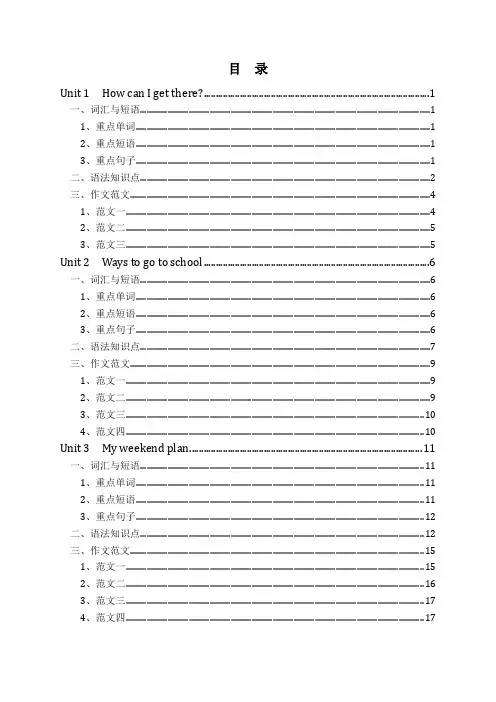
目录Unit 1 How can I get there? (1)一、词汇与短语 (1)1、重点单词 (1)2、重点短语 (1)3、重点句子 (1)二、语法知识点 (2)三、作文范文 (4)1、范文一 (4)2、范文二 (5)3、范文三 (5)Unit 2 Ways to go to school (6)一、词汇与短语 (6)1、重点单词 (6)2、重点短语 (6)3、重点句子 (6)二、语法知识点 (7)三、作文范文 (9)1、范文一 (9)2、范文二 (9)3、范文三 (10)4、范文四 (10)Unit 3 My weekend plan (11)一、词汇与短语 (11)1、重点单词 (11)2、重点短语 (11)3、重点句子 (12)二、语法知识点 (12)三、作文范文 (15)1、范文一 (15)2、范文二 (16)3、范文三 (17)4、范文四 (17)Unit 4 I have a pen pal (18)一、词汇与短语 (18)1、重点单词 (18)2、重点短语 (18)3、重点句子 (18)二、语法知识点 (19)三、作文范文 (23)1、范文一 (24)2、范文二 (24)3、范文三 (25)4、范文四 (25)Unit 5 What does he do (27)一、词汇与短语 (27)1、重点单词 (27)2、重点短语 (27)3、重点句子 (27)二、语法知识点 (28)三、作文范文 (30)1、范文一 (30)2、范文二 (31)3、范文三 (31)Unit 6 How do you feel (32)一、词汇与短语 (32)1、重点单词 (32)2、重点短语 (32)3、重点句子 (32)二、语法知识点 (33)三、作文范文 (34)1、范文一 (35)2、范文二 (35)3、范文三 (35)4、范文四 (35)语法知识点 (37)肯定句如何变否定句 (37)肯定句如何变一般疑问句 (39)划线部分提问(如何变特殊疑问句) (41)写作训练 (43)写作训练答案 (47)Unit 1 How can I get there?一、词汇与短语1、重点单词1.science /ˈsaɪəns/ 科学2.museum /mjuˈziːəm/ 博物馆3.post office /ˈpəʊst ɒfɪs/ 邮局4.bookstore /ˈbʊkstɔː/ 书店5.cinema /ˈsɪnəmə/ 电影院6.hospital /ˈhɒspɪtl/ 医院7.crossing /ˈkrɒsɪŋ/ 十字路口8.turn /tɜːn/ 转湾9.left /left/ 左10.right /raɪt/ 右11.straight /streɪt/ 笔直地12.ask /ɑːsk/ 问13.sir /sɜː(r)/ (对男子的礼貌称呼)先生14.interesting /ˈɪntrəstɪŋ/ 有趣的15.Italian /ɪˈtæliən/ 意大利的16.restaurant /ˈrestrɒnt/ 餐馆17.pizza /ˈpiːtsə/ 比萨饼18.street /striːt]/ 大街;街道19.get /get/ 到达20.gave /ɡeɪv/( give/ɡɪv/的过去式) 给21.follow /ˈfɒləʊ/ 跟着22.tell /tel/ 告诉2、重点短语1.science museum 科学博物馆2.near the library 图书馆附近3.get there 到达那里4.go straight 直走5.turn left/right 向左转/右转6.over there 在那边7.next to the museum 在博物馆旁边8.pet hospital 宠物医院9.Palace museum 故宫博物院10.in front of 在…前面11.behind the post office 在邮局后面12.beside the park 在公园旁边13.be far from 离……很远14.be far from home 远离家乡3、重点句子1. --Where is the museum shop?博物馆商店在哪里--It's near the door. 它在门附近。
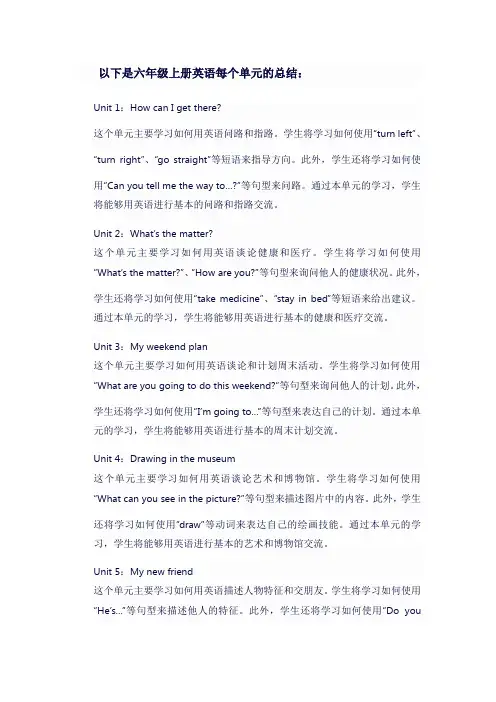
以下是六年级上册英语每个单元的总结:Unit 1:How can I get there?这个单元主要学习如何用英语问路和指路。
学生将学习如何使用“turn left”、“turn right”、“go straight”等短语来指导方向。
此外,学生还将学习如何使用“Can you tell me the way to…?”等句型来问路。
通过本单元的学习,学生将能够用英语进行基本的问路和指路交流。
Unit 2:What’s the matter?这个单元主要学习如何用英语谈论健康和医疗。
学生将学习如何使用“What’s the matter?”、“How are you?”等句型来询问他人的健康状况。
此外,学生还将学习如何使用“take medicine”、“stay in bed”等短语来给出建议。
通过本单元的学习,学生将能够用英语进行基本的健康和医疗交流。
Unit 3:My weekend plan这个单元主要学习如何用英语谈论和计划周末活动。
学生将学习如何使用“What are you going to do this weekend?”等句型来询问他人的计划。
此外,学生还将学习如何使用“I’m going to…”等句型来表达自己的计划。
通过本单元的学习,学生将能够用英语进行基本的周末计划交流。
Unit 4:Drawing in the museum这个单元主要学习如何用英语谈论艺术和博物馆。
学生将学习如何使用“What can you see in the picture?”等句型来描述图片中的内容。
此外,学生还将学习如何使用“draw”等动词来表达自己的绘画技能。
通过本单元的学习,学生将能够用英语进行基本的艺术和博物馆交流。
Unit 5:My new friend这个单元主要学习如何用英语描述人物特征和交朋友。
学生将学习如何使用“He’s…”等句型来描述他人的特征。
此外,学生还将学习如何使用“Do youwant to be my friend?”等句型来邀请他人交朋友。

【精选】人教pep版六年级上册英语第一单元Unit1《How can I get there?》重要知识点总结Unit1 How can I get there?一、重点单词和短语Science科学museum博物馆post office邮局bookstore书店cinema电影院hospital医院tasty美味的,可口的London Eye伦敦眼stomach胃crossing十字路口turn left/turn right向左/右转go straight=walk straight直走next to紧挨着/与……相邻far from(离……远)near在……附近behind(在……后面)in front of(在……前面)between…and…(在…和…之间)二、重点句子1.How do you go to school? 你是怎样去上学的?2.where is the restaurant? 餐馆在哪里?3. Usually I go to school on foot. 我通常走路去上学。
4. Sometimes I go by bike. 有时候我骑自行车去。
5.问路之前,出于礼貌,我们要说“Excuse me”与后面的句子要用标点符号隔开。
6.Look at the traffic lights, remember the traffic rules. 看着交通灯,记住交通规则。
7.Stop at a red light.Wait at a yellow light. Go at a green light.红灯停。
黄灯等一等。
绿灯行。
8.Red means stop, yellow means wait, green means go. 红色的意思是停止,黄色的意思是等待,绿色的意思是通行。
9.How can I get to the park? 我该怎样到达公园呢?10.You can go by the No.15 bus. 你可以坐15路公交车去。
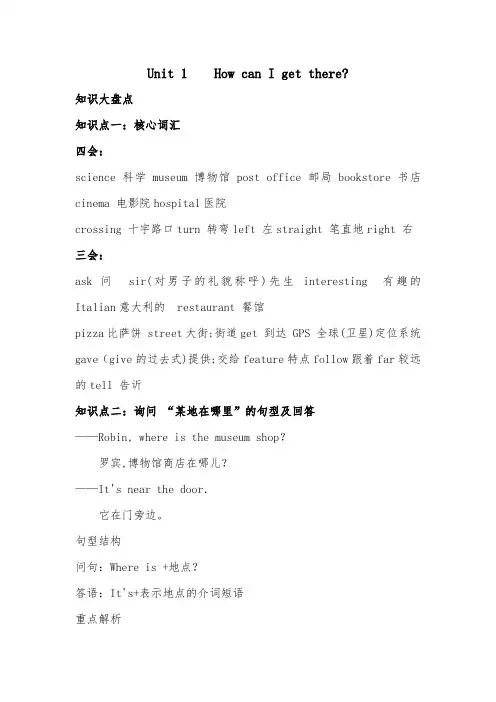
Unit 1 How can I get there?知识大盘点知识点一:核心词汇四会:science 科学museum 博物馆post office 邮局bookstore书店cinema 电影院hospital医院crossing 十宇路口turn 转弯left 左straight 笔直地right 右三会:ask问sir(对男子的礼貌称呼)先生interesting 有趣的Italian意大利的 restaurant 餐馆pizza比萨饼 street大街;街道get 到达 GPS 全球(卫星)定位系统gave(give的过去式)提供;交给feature特点follow跟着far较远的tell 告䜣知识点二:询问“某地在哪里”的句型及回答——Robin, where is the museum shop?罗宾,博物馆商店在哪儿?——It's near the door.它在门旁边。
句型结构问句:Where is +地点?答语:It's+表示地点的介词短语重点解析where意为“在哪儿”,用来询问地点。
表示地点的介词短语常见的有:next to the bookstore、 in front of the school、 on Dong fang Street、 over there 、 near the post office 等。
知识点三:表达“某人想要…I want to buy a postcard.我想买一个明信片。
句型结构(1)主语+want(s)+物品(2)主语十want(s) to十动词原形十其他。
重点解析此句型用于表达某人想要做某事,这是一个一般现在时的句子。
当主语是第三人称单数时,want 的形式要与主语一致,变为wants,其余主语时,调语动要用原形want。
包型(1)用来表示某人想要某物。
句型(2)用来表示某人想要做某事,to是不定式符号。
to后面要跟动词,需用原形。

UNIT 1 How can I get there? 我怎么到那儿?例文一:Lucy和她的朋友们要去一家意大利餐馆吃比萨饼。
请你根据提示写出他们行走的路线。
提示:他们从电影院的前面直走,到书店左转。
他们到达了医院的后面。
然后他们右转,再右转就到达餐馆了。
Lucy and her friends want to eat some pizza in an restaurant. They are i n front of the cinema now. They go straight and t urn left a t the bookstore. Now they are behind the hospital. They t urn right and then turn right again. Now they get to the restaurant.例文二:How to Get to the Science MuseumWe are going to the science museum tomorrow. The science museum is next to the h ospital. It’s near our school. So we can go there on foot. First, go straight from our school. Next, turn left at the post office and walk for five minutes. Then turn right at the bookstore. We can find the hospital on the right. Walk straight, and we’ll s ee the science museum.UNIT 2 Ways to go to school 去上学的方式例文一:谈谈你在日常生活中是怎样遵守交通规则的。

Unit1 How can I get there?一、单项选择。
(10分)() 1. —________. Where is the museum shop?—It's near the bookstore.A. You're welcomeB. Excuse meC. Sorry () 2. Turn right ________ the post office.A. offB. forC. at() 3. They want________ a new postcard.A. to buyB. buyC. buying () 4. ________beautiful flowers they are!A. What aB. WhatC. How () 5. I know a great ________ restaurant.A. ChinaB. ChineseC. china () 6. It's next to the park________Wuyue Street.A. fromB. forC. on() 7. How can I________?A. get to homeB. get homeC. gets home () 8. He can help the boy ________ that bookstore.A. findB. findsC. finding () 9. I'll________some questions.A. askB. askingC. to ask () 10. The pet hospital is ________ the park.A. nextB. next toC. of二、给下列问句选择正确的答语。
(10分)() 2. Is there a cinema near here?() 3. How can I get to the library?() 4. Is it far from your home?() 5. Where are they?三、情景对话。
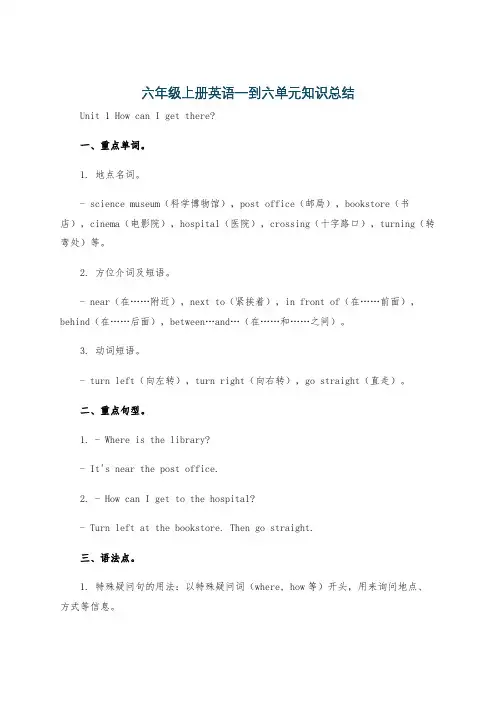
六年级上册英语一到六单元知识总结Unit 1 How can I get there?一、重点单词。
1. 地点名词。
- science museum(科学博物馆),post office(邮局),bookstore(书店),cinema(电影院),hospital(医院),crossing(十字路口),turning(转弯处)等。
2. 方位介词及短语。
- near(在……附近),next to(紧挨着),in front of(在……前面),behind(在……后面),between…and…(在……和……之间)。
3. 动词短语。
- turn left(向左转),turn right(向右转),go straight(直走)。
二、重点句型。
1. - Where is the library?- It's near the post office.2. - How can I get to the hospital?- Turn left at the bookstore. Then go straight.三、语法点。
1. 特殊疑问句的用法:以特殊疑问词(where, how等)开头,用来询问地点、方式等信息。
2. 一般现在时在问路指路中的运用。
Unit 2 Ways to go to school.一、重点单词。
1. 交通工具名词。
- by bike(骑自行车),by bus(乘公共汽车),by train(乘火车),by plane(乘飞机),on foot(步行),ship(轮船),subway(地铁)等。
2. 形容词。
- slow(慢的),fast(快的)。
3. 其他。
- traffic(交通),traffic lights(交通灯),stop(停),wait(等)。
二、重点句型。
1. - How do you come to school?- Usually, I come on foot.2. - How can I get to the Fuxing Hospital?- Take the No. 57 bus over there.三、语法点。
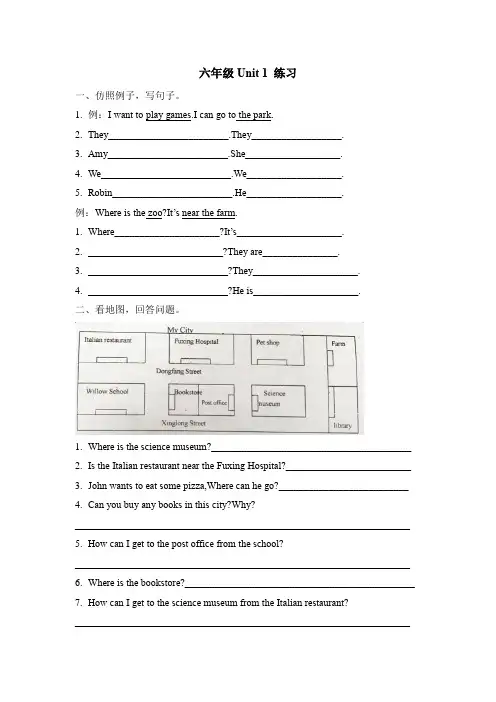
六年级Unit 1 练习一、仿照例子,写句子。
1.例:I want to play games.I can go to the park.2.They________________________.They__________________.3.Amy________________________.She___________________.4.We__________________________.We___________________.5.Robin________________________.He___________________.例:Where is the zoo?It’s near the farm.1.Where_____________________?It’s_____________________.2.___________________________?They are_______________.3.____________________________?They_____________________.4.____________________________?He is_____________________.二、看地图,回答问题。
1.Where is the science museum?________________________________________2.Is the Italian restaurant near the Fuxing Hospital?_________________________3.John wants to eat some pizza,Where can he go?__________________________4.Can you buy any books in this city?Why?___________________________________________________________________ 5.How can I get to the post office from the school?___________________________________________________________________6.Where is the bookstore?______________________________________________7.How can I get to the science museum from the Italian restaurant?___________________________________________________________________8.Is there a library in this city?___________________________________________9. Do you like this city?Why or why not?___________________________________________________________________ 10.What is in your city?Tell us,please.___________________________________________________________________11.I s the farm far from the school?________________________________________12.I s the library in front of the farm?_______________________________________13.C an you buy some lovely pets in this city?________________________________14.根据上图,选择一个地方,完成对话。
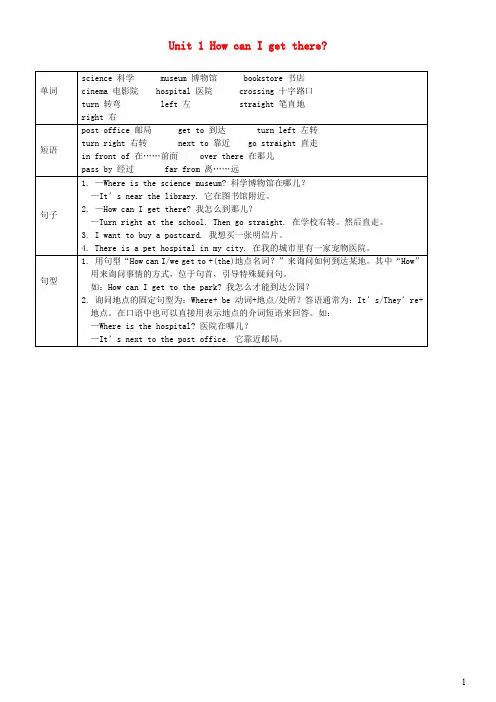
《Unit 1 How can I get there?》单元测试卷(一)(40分钟100分) 开始计时: ________Part 1 Speaking说(25%)一、跟读下列单词。
(10分)1. bookstore2. cinema3. hospital4. crossing5. left6. straight7. right8. interesting9. restaurant 10. street二、跟读下列句子或对话。
(5分)1. I want to buy a postcard.2. What a great museum!3. We are in front of the cinema.4. —Where is the science museum?—It is next to the park.三、跟读下面的对话。
(10分)A: Excuse me, sir. Is there a hospital in the city?B: Yes, there is.A: Where is it?B: It's near the bookstore. It is not far.A: How can I get to the hospital?B: Turn right at the zoo and go straight. Then turn left at the crossing and you can see the hospital.A: Thank you.B: You're welcome.Part 2 Listening听(25%)一、听录音,给图片标号。
(5分)()()( )()( )二、听问句,选择恰当的答语。
(5分)() 1. A. It's near the hospital.B. I want to go to the museum shop.C. The museum shop is far.() 2. A. We are in front of the cinema.B. There is a restaurant.C. Go straight and turn left at the bookstore.() 3. A. Yes, it is.B. It's next to the park.C. Let's go.() 4. A. It can find the way.B. It can find the food.C. It can find the stars.() 5. A. Sure.B. No, I can.C. Excuse me.三、听录音,找出下列人物要去的地方,在相应的栏中打“√”。
Unit1How can I get there?1.本单元重点语法:情态动词can的用法及其特殊疑问句的构成。
(练习题)2.本单元重点,难点及易考点A 部分Where is the science museum?1.Science museum 科学博物馆2.(1). where 引导的特殊疑问句(2). Mary lives in Shan Dong. (划线部分提问)It’s near the library.1.near 在......旁边My home is near the school.2.否定,疑问句的变化方式I see.How can I get there?1.see 用法(明白)看见时,read,see, watch, look 区别2.How 用法(1).提问方式:How do you get to school?(2).提问年龄:How old are you?(3).询问身体状况:How are you?(3).询问天气:How’s the weather today?(4).询问程度:How do you like Chinese food?=What do you think of the Chinese food?(5). how much,how many 区别_________ money does Mary have?_________books do you have?3. there 副词,go there , come here,go home(here)OK!Let’s go.1.let’s=let us +do Let’s have breakfast together.2.go 不及物动词Turn right at the school.Then go straight.1.turn right 向右转,turn left2.go straight直走Excuse me.Can you help me?help用法How can I get to the science museum?(练习句子)Mary 怎样到达学校呢?他怎样才能到家呢?It’s over there.over there在那边I want to buy a postcard.1.want用法2.buy 用法I want to send it today.send 用法What a great museum.感叹句(省略了it is)Thanks 用法跟踪练习题1.根据要求写做题。
Unit 1 How can I get there?一、单元词汇science museum科学博物馆post office 邮局bookstore书店cinema电影院hospital医院crossing十字路口turn left 向左转turn right 向右转ask问restaurant餐厅street街far 远的follow 跟着tell 告诉二、单元知识点关于一般疑问句的规则:①含有 be 动词充当谓语的句子或者含有情态动词(will 、can、should、would、may)的句子,改为疑问句时只须将be动词或情态动词提到句首即可;例如:They are all students→Are they all students?I can do some kung fu →Can you do any kung fu?rShe would like an hamburger→Would she like an hamburge?②含有实义动词充当谓语的句子,改为疑问句时在句首加do/does,主语是第三人称单数时加does,其他人称加do 即可;例如:They play football on the playground →Do they play on the playground I like making kites →Do you like making kites?She does housework on the weekend→Does she do house workon the weekend(主语实义动词的三单形式这时要去掉)Mike sings an English song → Does Mike sing an English song?另外要注意:改疑问句时第一人称和第二人称要互相转换;其次,如果句子含有 some,改为疑问句时要将some改为 any;练习:(1)、I know →_______________(2)、She knows →________________(3)、I will see a film tonight →_________________(4)、It is far from school →_____________________(5)、Mike goes to school with his friend→____________________(6)、You teach me English →______________________________1、I see,How can I get there?I see, 在这句话里, see不是“看见”的意思,而是“明白”I ,see 即“我明白”get there,意为“到达那里”,get 是动词,意为“到达”,get 后面加地点l get to the post office,时一般都要带有介词to,即get to + 地点,比如 get to schoo,get to the cinema;但是,当get后面接的是there,here和home的时候,则不需要添加介词to,直接写成get there,get here,get home即可此外,关于 here和there:Over there:在那边(表地点)——Where is the cinema?——It is over thereGet there:到达那里go there:去那里Get here:到达这里come here:来这里2、Where is the post office?Where,特殊疑问词,意为“哪里”,where is + 地点?,意为“......在哪里?”,该句型可以用来问路;提问:where is + 地点?回答:It’s + 方位介词+ 另一地点名词near、next to、in front of 、behind 等等例如:——Where is the cinema?——It is in front of the bookstore3、How can I get to the museum?How,特殊疑问词,意为“如何,怎样”;How can I get to + 地点?,意为“我如何才可以去到......?”,该句型用来询问去某地的具体走法;提问:How can I get to + 地点?回答:turn right / turn left / go straight例如:——How can I get to the science museum?——Turn left at the bookstore and it is on the right4、零散小知识点①turn left/right at + 地点,意为“在......处向左转/右转”,Turn left at the bookstoreTurn right at the post office再来,on the left,意为“在左边”,on the right“在右边”;——Where is the cinema?——It is on the left【拓展】You are right 的意思是什么?——How can I get to the nature park?——Go straight along the street and then turn right ____ the crossing, and it is ____ the left.A.in;atB.on;inC.at;onD.on;at②go straight for five miutes 直走五分钟动作+ for + 时间,表示这个动作持续了多长时间,for 后面接时间名词She cries for an hourWe sit here for thirty minutesShe stays at home for a whole day③go straight for ten minutes,then turn right at the bookstoreThen,意为“然后,接下来”5、I want to send it todayWant,动词,意为“想要”,want = would like ,它们不仅意思一样,用法也一样;Want/would like + sth,意为“想要某物”Want/would like to do sth,意为“想要做某事”I want an hamburger = I would like an hamburgerI want to eat an hamburger = I would like to eat an hamburgerI want a cup of coffee →I want to drink a cup of coffeeWant 和would like 的区别:Want 是实义动词,②类句子;would like 中的 would 是情态动词,①类句子;所以它们改为疑问句时的改法不一样;例如上例中:I want to eat an hamburger→I would like to eat an hamburger →6、What a great museum!What an interesting film!这两句都是what 引导的感叹句,英语中只有两类型的感叹句,一类是what 引导的,一类是how 引导的,这时候what 和how 都是“多么”的意思!不同的地方在于:what + 名词!How + 形容词!难点在于名词的辨别:girl,beautiful girl,a beautiful girlMother,my mother,my kind mother切记:形容词+名词= 名词!What a lovely dog!= How lovely the dog is!What an active boy!=What beautiful flowers!=7、Is the Thames far from here?Far,形容词,意为“远的”,be far from,意为“离......是很远的”;My home is far from schoolThe bookstore is far from the cinema8、零散小知识点:①on the stree,t意为“在街上”,注意要用介词on,不能用其他介词;on the DongFang street②but let’s eat first!First 为one的序数词,意为“第一”,第一件做的事是eat,即“首先”eat!看到 first 放在句末的时候,将它翻译为“首先”Let’s clean the window firstYou should finish your homework first,and then go climbing③that looks tastyLook,动词,在这里意为“看起来”,后接形容词作表语;You look so happyThe cake looks deliciousShe looks prettyUnit 1 单元习题一、选出与所给单词同类的一项。
人教PEP版六年级英语上册第一单元专项训练一、将正确答案的序号填在括号内。
1.I’m ____ now. I know a great restaurant. ()A.early B.fast C.hungry 2._____ swim in the Han River. It is very dangerous. ()A.Not B.Don't C.Doesn't 3.The subway is ______! ()A.come B.coming C.comes 4.Let's go straight and ___________ right. ()A.turn B.crossing C.ship 5.Take _________ over there. ()A.the NO.12 bus B.NO. the 12 bus C.NO.12 bus 6.They go to London _______ plane. ()A.on B.by C.with7.In U.S. you must wear a ______ when you ride a bike. ()A.helmet B.bell C.scarf8.My home is far from the park. So I _______ by bus.()A.get B.get there C.get to9.Little Jack sometimes goes home _________ foot. ()A.by B.at C.on10._______ a great museum! ()A.Where B.Who C.What11.It's red. We must stop and ________.()A.go B.wait C.slow12.I want ______ a bag. ()A.buy B.to buy C.buying13.The children ______ playing football. ()A.is B.are C.has14.We must ______ at a red light. ()A.go B.stop C.run15.Turn left _____ the cinema, then go straight. It’s _____ the right.()A.at; at B.at; on C.on; in16._____ and stop at a yellow light. ()A.Slow down B.Turn down C.Sit down17.________ run on the ferry. ()A.Do B.Does C.Don’t18.—________. Where is the post office?()—It’s next to the park.A.Hello B.Sorry C.Excuse me19.______ can I get there? ()A.Where B.How C.Who20.She can _______ the No. 12 bus to the park.()A.takes B.taking C.take21.Get off ______ the bus stop. The cinema is _____ the right. ()A.at; on B.at; at C.at; in22.I often go there ______ subway. ()A.by B.on C.with23._______ go at the red light. ()A.Let’s B.Don’t C.Please24.—______ is the post office? ()—It’s near the museum.A.What B.How C.Where25.This week I can stay with you. But I’ll go back to England ____. ()A.next week B.the next week C.last week 26.Chen Jie wants to ________ a tour guide for Oliver. ()A.is B.does C.be27.—______. ()—You’re welcome.A.Goodbye B.Hello C.Thank you 28.Mr Jones often goes to other countries ______. ()A.on foot B.by plane C.by bike 29.—How does he ______ to school? ()—He ______ to school by bus.A.go; goes B.goes; goes C.goes; go 30.Stop and wait at a _______ light. ()A.red B.yellow C.green31.My home is near my school. I usually go to school by _______. ( ) A.plane B.foot C.bike32.—________ can I go to the bookstore? ( )—You can go there by bus.A.What B.Where C.How33.The traffic light is yellow now. We must _______. ()A.slow down and stop B.go C.stop and wait 34.Don’t ______ on the ferry.()A.runs B.run C.running35.He often helps _______ with _______ English. ()A.she; her B.her; she C.her; her36.Amy goes to school _____ foot, because her home is _____. ()A.by; fast B.on; near C.in; far37.In the UK, you drive on the _______.()A.wrong B.right C.left38.It’s red now. ______ ()A.Let’s go.B.Stop and wait. C.Slow down and stop. 39.In the USA you must wear a _______ when you ride a bike.()A.helmet B.bell C.scarf40.How do you ________ the USA from China?()A.gets B.get to C.get41.You can walk to the museum, because it’s not _______. ()A.near B.far from C.far42.My school isn’t very far, so I go to school by ________. ()A.bike B.plane C.train43.—______ can I get to the science museum? ()—It’s over there.A.What B.Where C.How 44.Sometimes I go to the library ______ subway. ()A.on B.by C.at45.Usually I go to school on foot, because my home is ______.()A.far B.long C.near46.I usually go to school on foot, _______ by bike. ( )A.some B.sometime C.sometimes 47.There are ________ ways to go somewhere. ()A.a B.any C.many48._____ can we get there? ()A.What B.How C.Which49._______ go at a red light. ()A.Do B.Don’t C.Let’s 50.—Excuse me. Is there a cinema near here? ()—Yes, there is. It’s ______.A.beside the museum B.a post office C.turn right51._____ the No. 5 bus over there.()A.Ride B.Take C.Go52.—My father goes to work ______. ()—Wow! That’s a good exercise.A.on foot B.by car C.by taxi 53.Great! So many pictures ______ bikes. ()A.to B.from C.of54.You can go to the bus stop on _______.()A.train B.plane C.foot55.We must ______ at a red light. ()A.go B.slow C.stop56.I usually come to school by bike, but ______ I come on foot.()A.always B.sometimes C.often57.I have a _______ robot. It’s very clever. ()A.talk B.to talk C.talking58.You must ______ right before you cross the road. ()A.look B.looks C.looking59.He's a doctor. He works in a _____. ()A.hospital B.museum C.Restaurant60.The Italian restaurant is _____ the post office on Xinhua Street. ()A.next B.next to C.near to61.How can I __________ Linghu Park? ()A.get B.get to C.getting to62.You must ______ before you cross the road.()A.say hello B.look right C.sing a song 63.—The park is far from here. ()—Let’s go ________.A.on foot B.by bus C.by plane64.Mike goes to the zoo ______ bus. ()A.on B.in C.by65.We must pay attention to the traffic ______. ()A.light B.lights C.lightes.66._________ a great museum! ()A.How B.What C.Wow67.—________ is the library, please?()—It’s near the park.A.Where B.What C.How68.Let’s get there ______.()A.on ferry B.by a ferry C.by ferry69.______ usually go faster than buses because there is no heavy traffic(交通拥堵) under the ground. ()A.Subways B.Cars C.trains70.—How can I get to the science museum?()—Turn left ________ and you can see it.A.at the crossing B.in the crossing C.at the cross71.Do you go to the park ______. ()A.by a bus B.by the bus C.by bus72.I'm going to the _______. I want to buy some books. ()A.post office B.bookstore C.museum73.In the USA people on bikes must wear ________. ()A.a hat B.a helmet C.sunglasses 74.Usually I come to school ______ bike. ()A.in B.by C.on75.When the light is __________, we must slow down and stop. ()A.red B.green C.yellow 76.You can go there __________. It’s far from h ere. ()A.on foot B.by bus C.at school 77.Turn right ______ the bookstore. ()A.in B.near C.at 78.You must ________ and stop now.()A.slow down B.down slow C.fast 79.Stop at the _______. ()A.yellow light B.green light C.red light 80.I did the ________ last Monday. ()A.cleaning B.cleaned C.cleans(参考答案)一、将正确答案的序号填在括号内。
Unit 1 How can I get there?一.本单元重点语法:情态动词can的用法及其特殊疑问句的构成。
(练习题)二.本单元重点,难点及易考点A部分Where is the science museum?1.Science museum 科学博物馆2.(1). where 引导的特殊疑问句(2). Mary lives in Shan Dong. (划线部分提问)It’s near the library.1.near 在......旁边My home is near the school.2.否定,疑问句的变化方式I see. How can I get there?1.see用法(明白)看见时,read, see, watch, look区别2.How 用法(1). 提问方式:How do you get to school?(2). 提问年龄:How old are you?(3). 询问身体状况:How are you?(3). 询问天气:How’s the weather today?(4). 询问程度:How do you like Chinese food?=What do you think of the Chinese food?(5). how much, how many区别_________ money does Mary have?_________ books do you have?3. there 副词,go there , come here, go home(here)OK! Let’s go.1.let’s =let us +do Let’s have breakfast together.2.go 不及物动词Turn right at the school. Then go straight.1.turn right 向右转,turn left2.go straight 直走Excuse me. Can you help me?help用法How can I get to the science museum?(练习句子)Mary 怎样到达学校呢?他怎样才能到家呢?It’s over there.over there 在那边I want to buy a postcard.1.want用法2.buy用法I want to send it today.send用法What a great museum. 感叹句(省略了it is)Thanks 用法跟踪练习题一.根据要求写做题。
1.能,会_____________2. 向右转_____________3. 科学博物馆_____________4.go straight ____________5. 让我们_____________ 4. over there ______________ 二.选择正确的答案,将其序号填入题前的括号里。
1.___________ is the post office?A. How manyB. WhoC. Where2.I want __________ it.A. to sendB. sendsC. sending3.I don’t know. __________ ask.A. I’mB. I’llC. She4.What ___________ beautiful flower!A. anB. aC. the5._________ there a school near here?A. IsB. AreC. Does6.There is a hospital _________ my city.A. atB. inC. on7.A __________doll! How lovely!A. talkingB. talksC. to8.The museum is next ____________ the cinema.A. forB. inC. to9.Excuse ____________, where is the bookstore?A. meB. myC. I三.连词成句。
1. Where the is library ?2. want buy I book to a.3. near It’s the zoo.四.找出与例词同类的单词,将其序号写在相应的横线上。
A. whereB. hospitalC. in front ofD. cinemaE. whoF. behindG. near H. what I. school1.bookstore _____________ ______________ _________________2.next to ___________ ______________ ______________________3.whose _____________ _________________ __________________五.根据所给情景选出最佳答案。
1. 当你向他人问路时,有会有礼貌的说:Excuse me. B. I’m Mike C. How are you?2.当你想知道人民公园在哪时,你会问:A. Where is the Park?B. Where is the museum?C. How is the park?3. 别人问你图书馆在哪里,但是你不知道时,你会说:A. Thank youB. Welcom eC. I don’t know4. 你想买一个铅笔盒,你会对售货员说:A. I’ll askB. I like this shopC. I want to buy write a book.5.在书店你想买本书,你会对售货员说:A. I want to buy a bookB. I want to send a bookC.I want to write a book 六.根据要求完成句子。
1. My bike is over there. (划线部分提问)2.Mary wants to buy a book. (同上)3. I want ___________(have) breakfast. (用所给动词的适当适当形式填空)4. Let’s ___________(go) out for a walk. (同上)5. Thanks for ___________(tell)me this news.七.不全对话。
Mike: Robin, 1. __________ I want to send a letter.Robin: It’s near the museum.Mike: 2. _____________ where is the library? I want to read some books.Robin: Sorry, 3. _____________ I’ll ask. Excise me, sir. Is there a library in the city?Man: Yes, there is.Robin: 4. ____________Man: It’s next to the museum.Robin: Thank you very much.A. Thanks.B. Where is it?C. where is the past office?D. I don’t know.B部分I’m hungry now.hungry adj He is hungry.I know a great Italian restaurant.1.know用法2.Italian用法You like the pizza!like用法Then turn right at the hospital.hospital 用法Now we are in front of Tian’an.(1). in front of/ behind(2). in the front ofY ou are in a car.in a car. on a bus.Which of these can help you find a place?1.which 用法2.find用法give用法He now has GPS.1.否定,疑问2.have用法(单三)There is the restaurant.t here be 句型I’ll tell grandmother.1.tell用法2.ask用法My new GPS works.work用法序数词用法:1. 1-10基数词和序数词的写法2.序数词前必须加the。
How can they get there from the post office?1. get用法2. from用法(from...to...)Can you make sentences with these words?make 用法(1). 使役动词(2). make sentences 造句跟踪练习题一.选择每组单词中不同类的一项,将其题号填入题前的括号里。
( )1. A. robot B. buy C. send( )2. A. grandpa B. thank C. father( )3. A. great B. nice C. city( )4. A. pet B. nice C. city( )5. A. town B. sure C. village二.单项选择。
1.There is a hospital _______ my city.A. atB. inC. on2.A __________ doll! How lovey!A. talkingB. talksC. talk3.The museum is next _________ the cinema.A. forB. inC. to4.Excuse_________, where is the bookstore?A. meB. myC. I5.Sarah _________ a new compass.A. hasB. haveC. does6.We can ___________ the bookstore.A. giveB. helpC. find7.You can turn right __________ the zoo.A. onB. inC. at8.Please follow ____________.A. IB. meC. my9.Let’s clean our classroom __________.A. firstB. oneC. but三.写出下列单词的反义词形式。